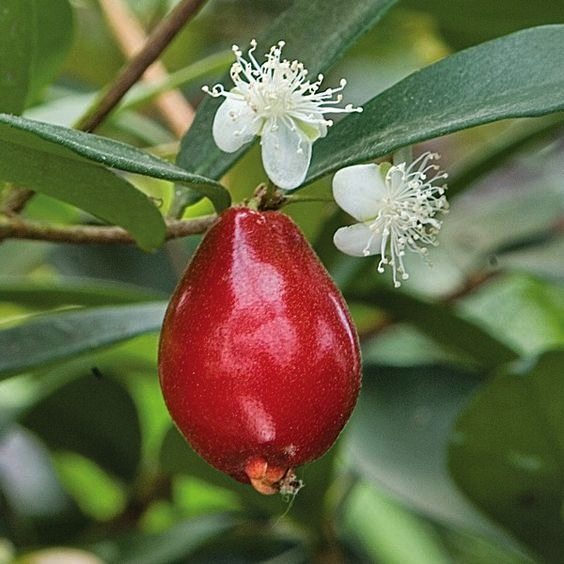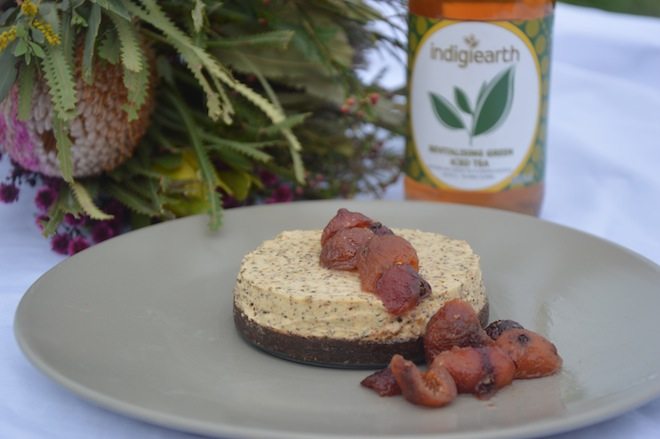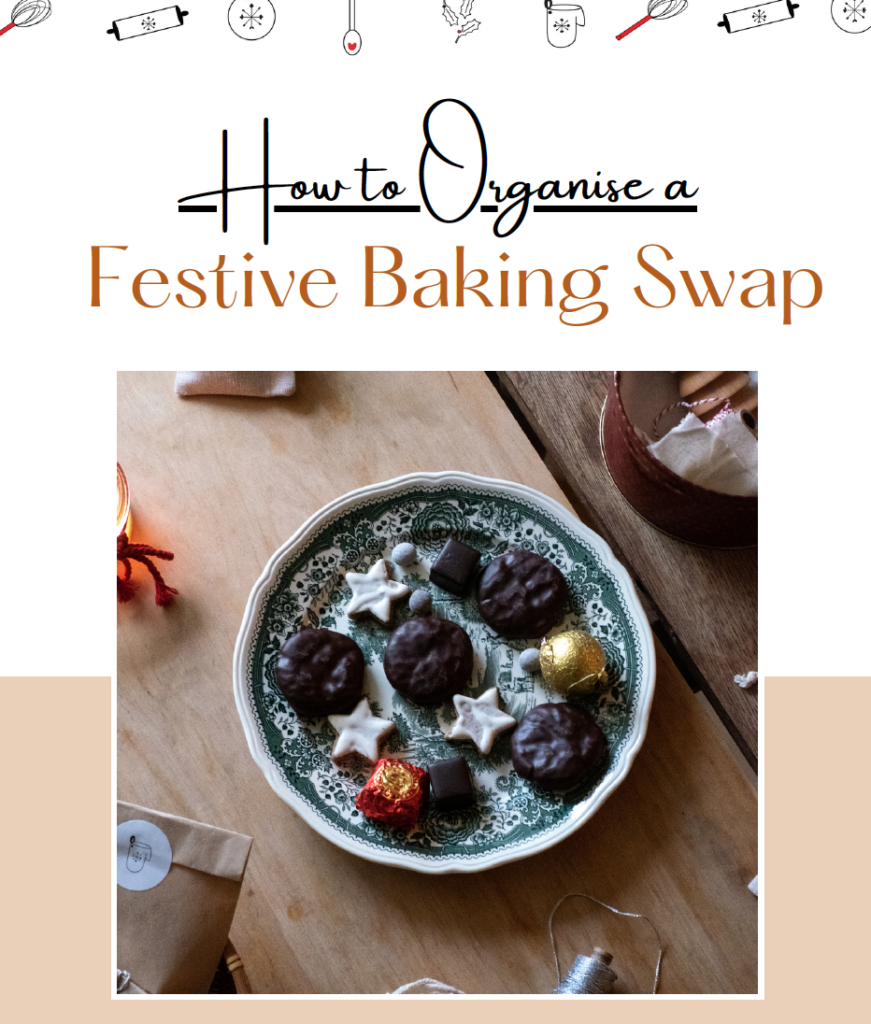 Quandong – image source: theleafstore.com.au
Quandong – image source: theleafstore.com.au
Native Australian Bush Food – A Beginner’s Guide
With Sharon Winsor, the CEO and founder of Indigiearth
By Jennifer Curcio
In this native Australian bush food beginner’s guide, Sharon Winsor, the CEO and founder of Indigiearth, an award winning native food and products business based out of NSW; has generously shared with me her wisdom, experience and knowledge. Sharon, a Ngemba Weilwan woman of Western NSW, grew up eating bush foods in the wild. She takes us through the basics of native Australian bush food – even sharing her prize winning recipe for double chocolate wattleseed cheesecake.
In this guide you’ll learn about the incredible amount of bush foods native to Australia, the six sacred seasons, where bush foods grow, as well as the Australian bush food chefs and cooks, farmers and producers that should be on our radar.
Native Australian Bush Food – A Beginner’s Guide
TYPES OF BUSH FOODS
Sharon, roughly how many native Australian bush foods would you say there are in circulation today?
In the commercial world and industry use, I would think there is approximately 50 bush tucker products that are known to this market. On the other hand, there are many other bush food ingredients that are out there – literally thousands.
 An Australian Beach Cherry – image source: Logees.com
An Australian Beach Cherry – image source: Logees.com
Which are the most common native Australian bush foods and which are rarer?
Some of the rarer ingredients that we are bringing to the market now is boab powder, quandong, pigface, naipan, cluster figs, oak wattle seed and beach cherries. Witjuti grubs have been know to the industry for many years, but there haven’t been many suppliers. We have brought them back to the market place, with myself going and collecting grubs on demand and on order.
Historically were native Australian herbs, spices and produce cultivated or were they found naturally and shared by communities?
Native ingredients were traditionally just wild harvested and collected on a needs basis. A majority of diet was based on fruits, smaller berries, small animals. Larger animals were not hunted and eaten on a regular basis. Our people also moved around, so that the bush foods wouldn’t be destroyed in that area. Trading foods with other tribal areas was also a big part of traditional life/diet. My people from out west would often travel towards the mountains and would trade red meats with sea foods/coastal people.
What kind of change have you seen to native Australian bush food in your lifetime?
There has been a massive change in the bush food industry over the past 20 years. I first started out in business almost 22 years ago in Western Sydney, operating a bush tucker catering business. At that time I don’t remember there being many Aboriginal owned and operated businesses operating a total bush tucker catering business. It was a hard industry to start – people’s perception of what bush tucker is was out of this world for me. Mention ‘bush tucker’ and people thought it was witjuti grubs and I was going to drag a goanna out the ute! Today there’s a lot more interest, people have realised what great stuff we have nurtured for thousands of years, the health benefits and the amazing flavours!
SEASONS/REGIONS
You reference the ‘six sacred seasons’. Could you give us an overview of the native seasons?
Traditionally we had 6 seasons, not 4. These times of the year represented many things for different tribal areas. In particular though – it represented new growth of foods, new cycles, ceremonies and special events that were celebrated through song, dance and food. These times also reflected what bush foods were in abundance.
SOURCING/PLANTING OF INGREDIENTS
Where are most native Australian bush foods located in terms of areas?
Bush foods are found in all parts of the country. Particular plants and ingredients are traditionally only grown in certain parts. For example bush tomato or the desert raisin as what it really is, traditionally only comes from Central Australia. Now there are people growing it in other parts of the country. Many bush foods are versatile and will adapt fairly well in many areas – but in traditional lore, that’s the wrong thing to do.
In terms of herbs, spices and produce, can they be grown in the average Australian backyard or do they require a specific climate?
There are quite a few spices and ingredients that can be grown in backyards. In fact many people have probably had native ingredients growing in the backyard, didn’t know it at the time and have pulled it out. One of my passions is to get many families growing bush foods in the backyard so that bush foods can be a part of every day diet & lifestyle for better health options.
 Rosella Berries – image source: Flickr
Rosella Berries – image source: Flickr
FARMERS, PRODUCERS, MAKERS, CHEFS
When you think of top native Australian bush food farmers and producers, who would you say are the best and why?
I would say Mayi Harvests in the Kimberleys would be a major leading supplier in quiet a few ingredients, including gubinge, giant lilly pilly, native lemongrass, boab, rosella and much more. They are traditional owners and custodians of the land they grow and harvest on. The family ensure sustainable and ethical practices are met, also still abiding by traditional lore. Traditionally bush tucker was just womens business – and they look after that very well with elders, aunties and the young girls. The second business would be Kungkas Can Cook in Alice Springs. Owner Rayleen Brown has family connections and ties with remote communities who also look after the bush foods under traditional customs. The produce is wild harvested, hand picked and the wilder the produce – the better they taste. We have teamed up with both of these businesses under the Five Kungkas Alliance, they are both exceptional in what they do.
Where are the best places to source ethical and organic native produce or meat?
In the Northern Territory there are farms that breed for the commercial industry. There’s a crocodile farm, there is another supplier who wild harvest’s the magpie goose. In QLD there is an Aboriginal owned and operated kangaroo processing plant. QLD also supplies emu meats that are bred for the food industry.
Which native Australian bush food chefs and cooks should we be aware of?
There’s a number of chefs and cooks out there that are doing some great stuff. Dale Chapman is a chef in the Brisbane district doing great things. Rayleen Brown from Kungkas Can Cook in Alice Springs, I guess myself as a cook in NSW, I would like to think that I’m doing some great stuff. Of course there is Mark Olive out there who has been doing some amazing things for a while as well. Aunty Beryl who has a cafe and heads up the Yaama.
 Lemon Myrtle – image source: Pinterest
Lemon Myrtle – image source: Pinterest
COOKING
How do you recommend balancing and experimenting with the flavours of native Australian bush food for beginners?
Have a go!! Play around with the ingredients, the same as you would when buying dried herbs from the supermarket. There’s lots of recipes on the internet now with bush foods. I would suggest making sure you taste the ingredients without anything else, so that you get an understanding of how strong the ingredients are. Most people go wrong by overloading with native ingredients, and not realising how strong they are. Don’t compare a lemon myrtle to lemon grass or any other lemony herb/spice. The lemon myrtle will be 10 times stronger.
What are some tips for discerning traditional native Australian cooking?
There is never a more suitable time to embark on native food cooking. There’s an abundance out in the market now, and most easily accessible. Cooking in a more traditional method includes cooking in the ground or on the coals, or in paperbark. Our people also used bark vessels to boil water, dilly bags made from vines and plant material to hang ingredients that needed hanging to dry or washed.
Are there any special utensils we should be using when cooking native Australian foods?
No, there are no special utensil required. All of your current utensils are fine.
If you could shortlist your favourite native foods and ingredients, which would those be?
Kangaroo, crocodile, wattleseed, quandongs and bush tomato.
 Sharon’s Double Chocolate Wattleseed Cheesecake – image source: Indigiearth
Sharon’s Double Chocolate Wattleseed Cheesecake – image source: Indigiearth
Could you share a native Australian bush food recipe with us?
One of my favourite and most easy bush food recipe’s is a Double Chocolate Wattleseed Cheesecake – basic but the flavours are intense. It has won myself a peoples choice award at a food and wine matching event last year (2015).
1pk Chocolate bikkies (arnotts choc ripple bikkies or similar are fine)
100g butter, melted
2 tbs hot water
1 tbs gelatine powder
2 x 250g pkts of cream cheese, room temperature
1 cup thickened cream
3/4 cup caster sugar
200g roasted wattleseed
150g white chocolate melted, cooled
50g milk or dark chocolate melted, cooled
- Brush a 16 x 26cm slab pan with melted butter to grease. Line the base and two long sides with non-stick baking paper, allowing the sides to overhang.
- Process the biscuits in a food processor until finely crushed. Combine 100g roasted wattleseed, Add the butter and process until well combined. Use the back of a metal spoon to spread and press the biscuit mixture evenly over the base of the pan. Cover with plastic wrap. Place in the fridge for 30 minutes to chill.
- Meanwhile, place the hot water in a small heatproof bowl. Sprinkle with gelatine. Place the bowl in a saucepan of simmering water and stir for 2 minutes or until the gelatine dissolves. Set aside for 5 minutes to cool.
- Use an electric beater to beat the cream cheese, cream the sugar and the 100g of wattleseed in a bowl until smooth. Add the white chocolate and beat until well combined. Beat in the gelatine mixture. Pour into the prepared pan.
- Drizzle the dark chocolate over the cheesecake. Use a skewer to create a swirled effect.
- Place in the fridge for 4 hours or until set. Cut into squares to serve.
Another favourite is a simple spaghetti bolognese – substitute the beef mince with kangaroo mince, use bush tomato chutney instead of tomato paste and add some native thyme. A rich meal full of flavour! For more recipes, visit Sharon’s site here.

ABOUT SHARON
Sharon Winsor is a descendant of the Ngemba Nation, Weilwan Clan, Western NSW. She is the CEO and Founder of Indigiearth.
Sharon grew up in Gunnedah and Coonabarabran where her passion for bush foods began. Eating bush foods in the wild was a necessity during childhood, now she has pure pride and passion in being able to bring what Mother Earth has provided for everyone, in many different ways, and in its purist form.
Indigiearth has become a leader in the native foods/products industry creating a retail range of foods, ingredients, beverages, as well as a premium range of natural native skincare products. In 2011 Sharon produced the first natural bottled spring water from a culturally appropriate water source. In 2013 Sharon was the first Aboriginal person to be awarded the NSW Business Chamber’s NSW Business Leader of the Year.
Sharon is also the lead singer of the Indigiearth Dancers, her professional and unique traditional Aboriginal dance group, who perform traditional song and dance from the Ngemba tribe. Sharon has been performing professionally for 15 years and led her professional dance group through performances for clients such as P & O Cruises, Queen Elizabeth cruise liners, Tyra Banks & America’s Next Top Model and Oprah Winfrey’s ultimate Australian experience to name a few.
Website: www.indigiearth.com.au
Twitter: indigiearth
Instagram: indigiearth
Consciousness: All of Indigiearth’s packaging is environmentally friendly. Their practices of bush foods follow their own traditional rituals of sourcing from sustainable harvesting, and where those ingredients are traditionally grown.
Indigiearth have also been in the process of setting up their own foundation, the Ngukirri foundation. Ngukirri in Ngemba language means “to give”. Ngukirri is also the name of Sharon’s first born son, who was still born at 40 weeks. He had a hole in the heart. The foundation in his memory, will provide much needed assistance, support, education and equipment to rural and remote communities to assist in heart care, treatment, healthy eating programs, education about heart diseases.
 Kakadu Plum – image source: AustralianGeographic.com.au
Kakadu Plum – image source: AustralianGeographic.com.au









